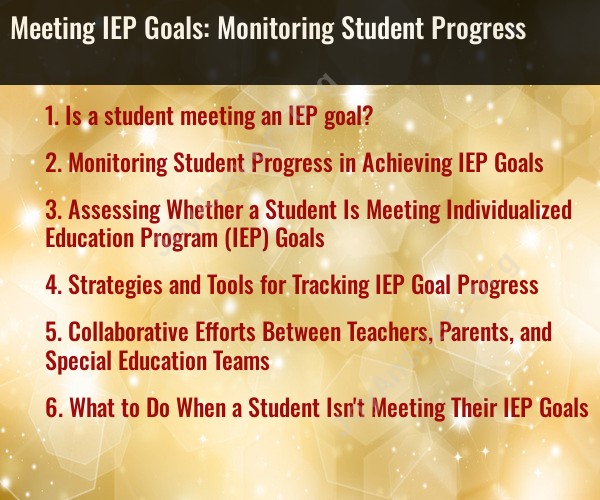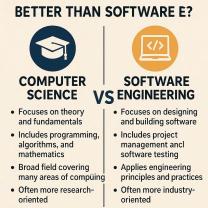Is a student meeting an IEP goal?
The determination of whether a student is meeting their Individualized Education Program (IEP) goals is an ongoing process that involves monitoring and assessing the student's progress. An IEP is a legally binding document developed for students with disabilities, outlining their specific learning needs, the services and accommodations they require, and the goals they are expected to achieve. Here's how the process of monitoring student progress with respect to IEP goals typically works:
Setting IEP Goals: The IEP team, which includes parents, teachers, special education professionals, and sometimes the student, establishes specific and measurable goals for the student. These goals are tailored to the student's unique needs and may cover areas such as academics, behavior, social skills, communication, and more.
Implementing the IEP: Teachers and other professionals work with the student to provide the necessary support and accommodations outlined in the IEP. This may involve modifying the curriculum, providing extra help, or offering specialized services.
Progress Monitoring: Regularly scheduled meetings are held to review the student's progress toward the IEP goals. These meetings often occur at least annually, but can also take place more frequently. During these meetings, the team assesses whether the student is making progress toward their goals.
Data Collection: Data and assessments are used to track the student's performance. This can include standardized tests, classroom observations, work samples, and other measures. The collected data help determine whether the student is meeting their IEP goals.
Adjusting the IEP: If the student is not making satisfactory progress toward their goals, the IEP may need to be adjusted. The IEP team can make changes to the goals, services, or accommodations to better support the student's needs.
Continual Review: The process of monitoring and adjusting the IEP continues as long as the student is receiving special education services. The goal is to ensure that the student receives the appropriate support and has the opportunity to make progress in their education.
In summary, the question of whether a student is meeting an IEP goal is determined through an ongoing process of monitoring, assessment, and collaboration between the IEP team members. If a student is not making progress, the IEP can be adjusted to better address their needs and support their development. The ultimate aim of the IEP is to help students with disabilities reach their educational potential and meet their goals.
Monitoring Student Progress in Achieving IEP Goals
Monitoring student progress in achieving IEP goals is an essential part of the special education process. It allows teachers, parents, and special education teams to identify students who are making progress towards their goals, as well as students who may need additional support.
There are a variety of ways to monitor student progress in achieving IEP goals. Some common strategies include:
- Collecting data on student performance: This can be done through formal assessments, such as tests and quizzes, as well as informal assessments, such as observations and work samples.
- Tracking student progress over time: This can be done by creating graphs or charts that show how a student is performing on each of their IEP goals.
- Comparing student progress to benchmarks: This can be done by comparing a student's performance to the performance of other students with similar disabilities.
Assessing Whether a Student Is Meeting Individualized Education Program (IEP) Goals
To assess whether a student is meeting their IEP goals, teachers and special education teams will typically review the student's data and progress charts. They will also consider the student's individual needs and progress in relation to their peers.
If a student is meeting their IEP goals, the team will continue to provide support and monitor their progress. If a student is not meeting their IEP goals, the team will meet to discuss the student's needs and develop a plan to provide additional support.
Strategies and Tools for Tracking IEP Goal Progress
There are a variety of strategies and tools that can be used to track IEP goal progress. Some common strategies include:
- Progress monitoring tools: These tools can be used to collect and track data on student performance over time. Some common progress monitoring tools include DIBELS, AIMSweb, and Curriculum-Based Measurement (CBM).
- Data binders: Data binders can be used to organize and store student data, such as test scores, work samples, and progress charts.
- IEP progress monitoring software: There are a variety of software programs available that can be used to track IEP goal progress. These programs can generate reports and graphs that can be used to identify students who are making progress towards their goals, as well as students who may need additional support.
Collaborative Efforts Between Teachers, Parents, and Special Education Teams
Collaboration between teachers, parents, and special education teams is essential for effective IEP goal monitoring. Teachers can provide parents with information about their child's progress and strategies for supporting their learning at home. Parents can provide teachers with information about their child's interests and needs. Special education teams can provide teachers and parents with support and guidance on IEP goal monitoring and progress.
What to Do When a Student Isn't Meeting Their IEP Goals
If a student is not meeting their IEP goals, the teacher, parents, and special education team will meet to discuss the student's needs and develop a plan to provide additional support. This plan may include:
- Adjusting the student's IEP goals: If the student's goals are too difficult, the team may adjust them to make them more realistic and achievable.
- Providing more intensive instruction: The student may need to receive more individualized instruction or small group instruction in order to make progress.
- Using different teaching methods: The teacher may try different teaching methods or strategies to help the student learn.
- Involving other professionals: The team may involve other professionals, such as a school psychologist or speech-language pathologist, to provide additional support to the student.
If a student is still not making progress after the team has implemented additional supports, the team may decide to convene an IEP meeting to discuss the student's needs and make changes to the IEP.













